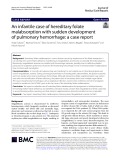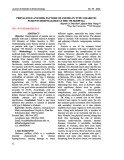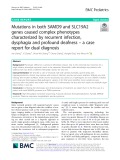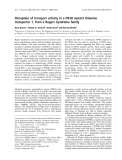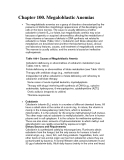
Megaloblastic anemia
-
Hereditary folate malabsorption—a rare disorder caused by impairment of the folate transporter—can develop into severe folate deficiency manifesting as megaloblastic anemia and occasionally thrombocytopenia. Reportedly, megaloblastic anemia can manifest with hemorrhagic episodes, possibly due to ineffective platelet production and platelet dysfunction.
 6p
6p  vigamora
vigamora
 23-05-2023
23-05-2023
 5
5
 2
2
 Download
Download
-
Determination of anemia rate in patients with type 2 diabetes treated at hospital 199 Ministry of Public Security in 2021. Understanding some factors related to anemia in patients with type 2 diabetes treated at hospital 199 Ministry of Public Security in 2021.
 9p
9p  videadpool
videadpool
 06-05-2023
06-05-2023
 3
3
 2
2
 Download
Download
-
Megaloblastic anemia or bone marrow changes could occur after prolonged nitrous oxide inhalation via vitamin B12 inactivation related DNA synthesis impairment. Previous researches have studied hematological changes with nitrous oxide exposure, but only in adults or adolescents. Pre-school age children with active hematopoietic red bone marrow are more vulnerable to potential side effects of nitrous oxide and might experience growth impairment.
 8p
8p  vidietmarhopp
vidietmarhopp
 28-12-2021
28-12-2021
 11
11
 0
0
 Download
Download
-
Phenotypic difference is general in Mendelian disease. Due to the extremely low incidence for a single disease, phenotype spectrum needs to be expanded. Meanwhile, earlier knowledge says patients who suffered from two kinds of different Mendelian disease are very rare.
 5p
5p  virome2711
virome2711
 13-01-2020
13-01-2020
 16
16
 0
0
 Download
Download
-
Thiamine-responsive megaloblastic anemia (TRMA) is a rare autosomal recessive inherited disease characterized by the clinical triad of megaloblastic anemia, sensorineural deafness, and diabetes mellitus. To date, only 100 cases of TRMA have been reported in the world.
 6p
6p  virome2711
virome2711
 13-01-2020
13-01-2020
 10
10
 0
0
 Download
Download
-
Rogers syndrome is an autosomal recessive disorder result-ing in megaloblastic anemia, diabetes mellitus, and sensori-neural deafness. The gene associated with this disease encodes for thiamine transporter 1 (THTR1), a member of the SLC19 solute carrier family including THTR2 and the reduced folate carrier (RFC). Using transient transfections into NIH3T3 cells of a D93H mutant THTR1derived from a Rogers syndrome family, we determined the expression, post-translational modification, plasma mem-brane targeting and thiamine transport activity.
 9p
9p  fptmusic
fptmusic
 12-04-2013
12-04-2013
 41
41
 1
1
 Download
Download
-
T he science of human nutrition and its applications to health promotion continue to gain momentum. In the relatively short time since the release of the first edition of this Encyclopedia, a few landmark discoveries have had a dramatic multiplying effect over nutrition science: the mapping of the human genome, the links between molecular bioenergetics and lifespan, the influence of nutrients on viral mutation, to name a few.
 170p
170p  cronus75
cronus75
 14-01-2013
14-01-2013
 69
69
 5
5
 Download
Download
-
The megaloblastic anemias are a group of disorders characterized by the presence of distinctive morphologic appearances of the developing red cells in the bone marrow. The cause is usually deficiency of either cobalamin (vitamin B12) or folate, but megaloblastic anemia may arise because of genetic or acquired abnormalities affecting the metabolism of these vitamins or because of defects in DNA synthesis not related to cobalamin or folate (Table 100-1).
 24p
24p  socolanong
socolanong
 25-04-2012
25-04-2012
 62
62
 3
3
 Download
Download
-
Anemia occurs in ~80% of myeloma patients. It is usually normocytic and normochromic and related both to the replacement of normal marrow by expanding tumor cells and to the inhibition of hematopoiesis by factors made by the tumor. In addition, mild hemolysis may contribute to the anemia. A larger than expected fraction of patients may have megaloblastic anemia due to either folate or vitamin B12 deficiency. Granulocytopenia and thrombocytopenia are very rare.
 7p
7p  thanhongan
thanhongan
 07-12-2010
07-12-2010
 77
77
 6
6
 Download
Download
-
Bone Marrow The bone marrow is usually normal or hypercellular, but in 20% of cases it is sufficiently hypocellular to be confused with aplasia. No single characteristic feature of marrow morphology distinguishes MDS, but the following are commonly observed: dyserythropoietic changes (especially nuclear abnormalities) and ringed sideroblasts in the erythroid lineage; hypogranulation and hyposegmentation in granulocytic precursors, with an increase in myeloblasts; and megakaryocytes showing reduced numbers or disorganized nuclei.
 4p
4p  thanhongan
thanhongan
 07-12-2010
07-12-2010
 74
74
 4
4
 Download
Download
-
Folinic Acid (5-Formyl-Thf) This is a stable form of fully reduced folate. It is given orally or parenterally to overcome the toxic effects of methotrexate or other DHF reductase inhibitors. Prophylactic Folic Acid In many countries, food is fortified with folic acid (in grain or flour) to prevent neural tube defects. It is also used in chronic dialysis patients and in parenteral feeds.
 7p
7p  thanhongan
thanhongan
 07-12-2010
07-12-2010
 72
72
 4
4
 Download
Download
-
Nutritional Dietary folate deficiency is common. Indeed, in most patients with folate deficiency a nutritional element is present. Certain individuals are particularly prone to have diets containing inadequate amounts of folate (Table 100-5). In the United States and other countries where fortification of the diet with folic acid has been adopted, the prevalence of folate deficiency has dropped dramatically and is now almost restricted to high-risk groups with increased folate needs.
 5p
5p  thanhongan
thanhongan
 07-12-2010
07-12-2010
 50
50
 3
3
 Download
Download
-
Antifolate Drugs A large number of epileptics, who are receiving long-term therapy with phenytoin or primidone, with or without barbiturates, develop low serum and red cell folate levels. The exact mechanism is unclear. Alcohol may also be a folate antagonist, as patients who are drinking spirits may develop megaloblastic anemia that will respond to normal quantities of dietary folate or to physiologic doses of folic acid only if alcohol is withdrawn. Macrocytosis of red cells is associated with chronic alcohol intake even when folate levels are normal.
 5p
5p  thanhongan
thanhongan
 07-12-2010
07-12-2010
 57
57
 3
3
 Download
Download
-
Serum Folate This is also measured by an ELISA technique. In most laboratories, the normal range is from 11 nmol/L (2.0 µg/L) to ~82 nmol/L (15 µg/L). The serum folate level is low in all folate-deficient patients. It also reflects recent diet. Because of this, serum folate may be low before there is hematologic or biochemical evidence of deficiency.
 5p
5p  thanhongan
thanhongan
 07-12-2010
07-12-2010
 58
58
 3
3
 Download
Download
-
Acquired Abnormality of Cobalamin Metabolism: Nitrous Oxide Inhalation Nitrous oxide irreversibly oxidizes methylcobalamin to an inactive precursor; this inactivates methionine synthase. Megaloblastic anemia has occurred in patients undergoing prolonged N2O anesthesia (e.g., in intensive care units). A neuropathy resembling cobalamin neuropathy has also been described in dentists and anesthetists who are repeatedly exposed to N 2O. Methylmalonic aciduria does not occur as adocobalamin is not inactivated by N2O.
 5p
5p  thanhongan
thanhongan
 07-12-2010
07-12-2010
 63
63
 6
6
 Download
Download
-
Table 100-4 Malabsorption of Cobalamin May Occur in the Following Conditions But Is Not Usually Sufficiently Severe and Prolonged to Cause Megaloblastic Anemia Gastric causes Simple atrophic gastritis (food cobalamin malabsorption) Zollinger–Ellison syndrome Gastric bypass surgery Use of proton pump inhibitors Intestinal causes Gluten-induced enteropathy Severe pancreatitis HIV infection Radiotherapy Graft-versus-host disease Deficiencies of cobalamin, folate, protein, ?riboflavin, ?nicotinic acid Therapy with colchicine, para-aminosalicylate, neomycin, slow-release potassi...
 5p
5p  thanhongan
thanhongan
 07-12-2010
07-12-2010
 71
71
 2
2
 Download
Download
-
Serum Antibodies Two types of IF immunoglobulin G antibody may be found in the sera of patients with PA. One, the "blocking," or type I, antibody, prevents the combination of IF and cobalamin, whereas the "binding," or type II, antibody prevents attachment of IF to ileal mucosa. Type I occurs in the sera of ~55% of patients and type II in 35%. IF antibodies cross the placenta and may cause temporary IF deficiency in the newborn infant. Patients with PA also show cellmediated immunity to IF. Type I antibody has been detected rarely in the sera of patients without...
 5p
5p  thanhongan
thanhongan
 07-12-2010
07-12-2010
 61
61
 2
2
 Download
Download
-
Tropical Sprue Nearly all patients with acute and subacute tropical sprue show malabsorption of cobalamin; this may persist as the principal abnormality in the chronic form of the disease, when the patient may present with megaloblastic anemia or neuropathy due to cobalamin deficiency. Absorption of cobalamin usually improves after antibiotic therapy and, in the early stages, folic acid therapy. Fish Tapeworm Infestation The fish tapeworm (Diphyllobothrium latum) lives in the small intestine of humans and accumulates cobalamin from food, rendering this unavailable for absorption.
 5p
5p  thanhongan
thanhongan
 07-12-2010
07-12-2010
 51
51
 2
2
 Download
Download
-
An underlying maternal folate metabolic abnormality has also been postulated. One abnormality has been identified: reduced activity of the enzyme 5,10-methylene-THF reductase (MTHFR) (Fig. 100-1) caused by a common 677CÆT polymorphism in the MTHFR gene. In one study, the prevalence of this polymorphism was found to be higher in the parents of NTD fetuses and in the fetuses themselves: homozygosity for the TT mutation was found in 13% compared with 5% in control subjects. The polymorphism codes for a thermolabile form of MTHFR.
 5p
5p  thanhongan
thanhongan
 07-12-2010
07-12-2010
 64
64
 3
3
 Download
Download
-
Most foods contain some folate. The highest concentrations are found in liver, yeast, spinach, other greens, and nuts (100 µg/100 g). The total folate content of an average Western diet is ~250 µg daily, but the amount varies widely according to the type of food eaten and the method of cooking. Folate is easily destroyed by heating, particularly in large volumes of water. Total-body folate in the adult is ~10 mg, the liver containing the largest store. Daily adult requirements are ~100 µg, so stores are only sufficient for 3–4 months in normal adults and severe folate deficiency may...
 5p
5p  thanhongan
thanhongan
 07-12-2010
07-12-2010
 62
62
 2
2
 Download
Download
CHỦ ĐỀ BẠN MUỐN TÌM








